This blog article is part of the 20sPeople season – a season of exhibitions, activities and events from The National Archives that explores and shares stories that connect the people of the 2020s with the people of the 1920s.
The 1920s was a period of great innovation in decorative design of all kinds, from fashion to home furnishing. The changes in women’s fashion are well known, as radical trends transformed women’s wardrobes offering newfound physical freedom. At the same time, the built environment and material culture was changing, exhibiting new innovative design features as modernist and Art Deco movements left their marks both inside and outside the home. Developments in design across these different areas of life were interconnected and were influenced by larger changes in society.
The registered design collection at The National Archives offers us a unique insight into 1920s design. From 1839, individuals and companies could register decorative designs for copyright protection with the Designs Registry, part of the Board of Trade. Registering required a representation (a drawing, photograph or sample) to be submitted, and these designs are now held at The National Archives along with their details of registration under department code BT. In the 1920s, designs were classified as either textiles or non-textiles and the records from this era include a wide range of different types of design, including fashion, accessories, furniture, ornaments, wallpaper and fabrics of various kinds.
A shift in fashion
As the 1920s dawned, the modernisation of women’s dress, that began in the previous decade, accelerated. The simple chemise or shift dress soon became the dominant style for day and evening wear, particularly among younger fashion-conscious women , with dropped waists and hemlines reaching to the calf or just below the knee in most cases (see footnote 1).
The physical freedom provided by these simpler styles of dress reflected the increasing social freedom experienced by many women in the 1920s. More women were in employment and women finally gained the vote on equal terms as men through the Equal Franchise Act of 1928 (currently on display at The National Archives’ exhibition The 1920s: Beyond the Roar). The developments were also accelerated by the First World War, as many more women were involved in physical work in factories and on farms and so embraced the convenience and comfort of trousers and shorter skirts (footnote 2).

Designers were also catering for the leisured classes’ enthusiasm for sport and outdoor pursuits. Specialised garments were designed for tennis, swimming, motoring and aviation. In an issue of the Illustrated London News, published on 5 January 1929, the ‘Fashions and Fancies’ page informs readers about great offers available in the January sales (footnote 3).
A smart travelling coat of nappa leather for motoring, travelling and general country wear, which has been reduced in price for the sale at Dunhill’s 2, Conduit Street, W., the famous specialists in motoring outfits.
Designers took inspiration from around the world, reviving Chinoiserie styles and Orientalist influences – drawing on ‘exotic’ imagery from a historical and mythical East. These influences can be found in the use of colour and pattern, but also in the design of entire garments such as kimono capes, harem trousers and turbans (footnote 4). This tunic registered by Liberty & Co. in 1925 exhibits elements of the Chinoiserie style in its pattern and design.
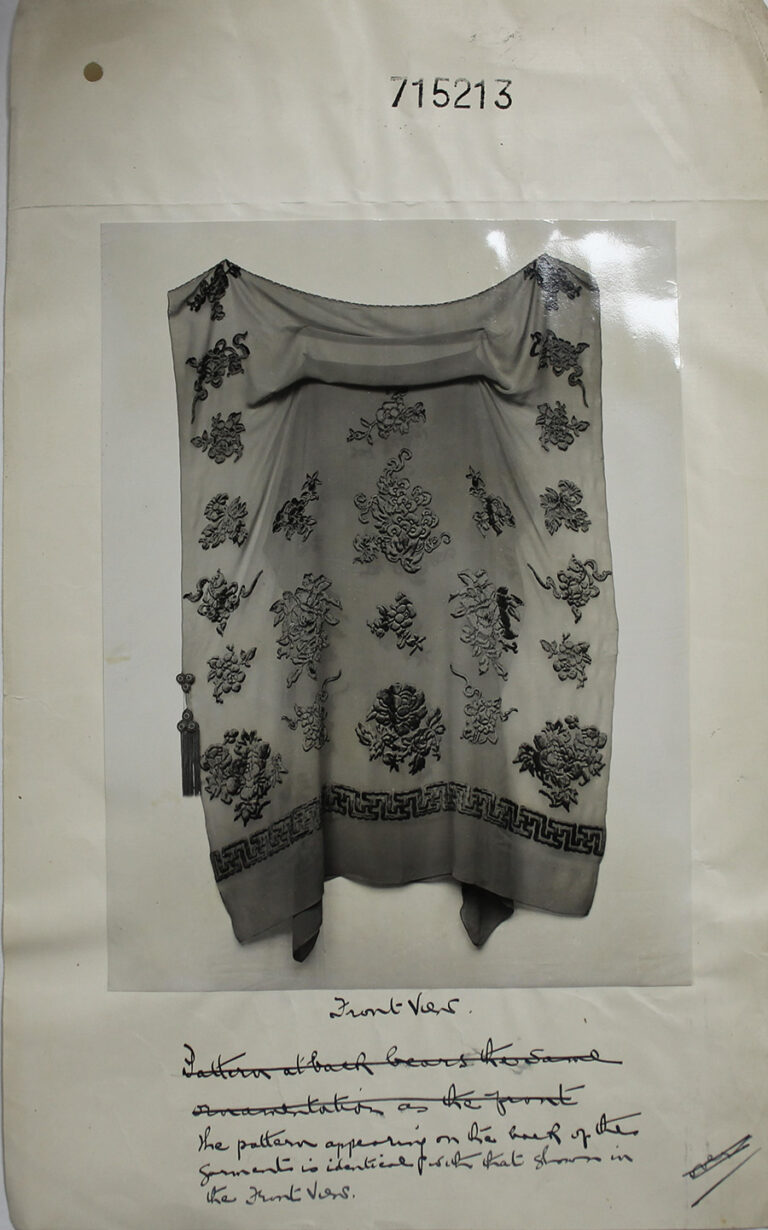
The simplification of clothing designs was an important factor in the democratisation of fashion. Simple designs made it easier for women to make their own garments at home, following patterns in magazines. It also became easier for manufacturers to produce ready-to-wear clothing and this industry flourished.
Shoes and accessories
As hemlines rose above the ankle, shoes were now on show! Consequently there was an increased interest in designing beautiful footwear to complement the ensemble. Pump-style shoes with a mid-height heel were the most popular option during the 1920s.
These shoe designs on the left were registered on 19 May 1924 by Henri Hellstern. Hellstern & Sons was a successful shoe designer and manufacturer founded in Paris in 1870. These shoes exhibit the ‘Louis’ style of curved heel which was popular in the first half of the decade. This style of heel widened at the bottom, increasing stability and was named after King Louis XV of France due to its popularity in his court (footnote 5). On the right we see a design registered by Societé Anonyme des Établissements Monteux in 1927, showing a straighter heel which became more popular later in the decade.
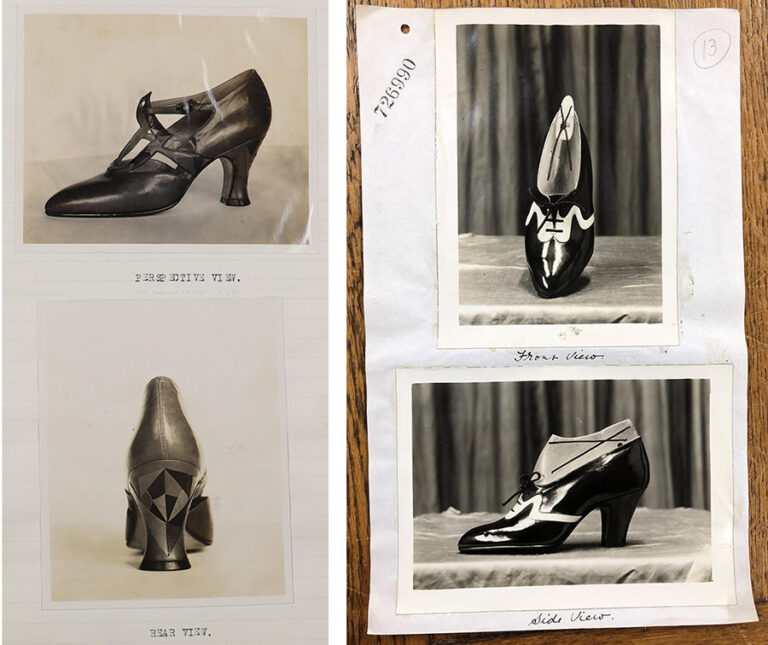
Modernist ideas of simplicity also had an impact on jewellery design in the 1920s. There was less of a focus on valuable materials and precious stones as women embraced costume jewellery in the form of long beaded and pearl necklaces, sometimes in bold colours. This necklace was registered on 20 February 1920 by George Oliver Restall of Sambourne near Redditch.
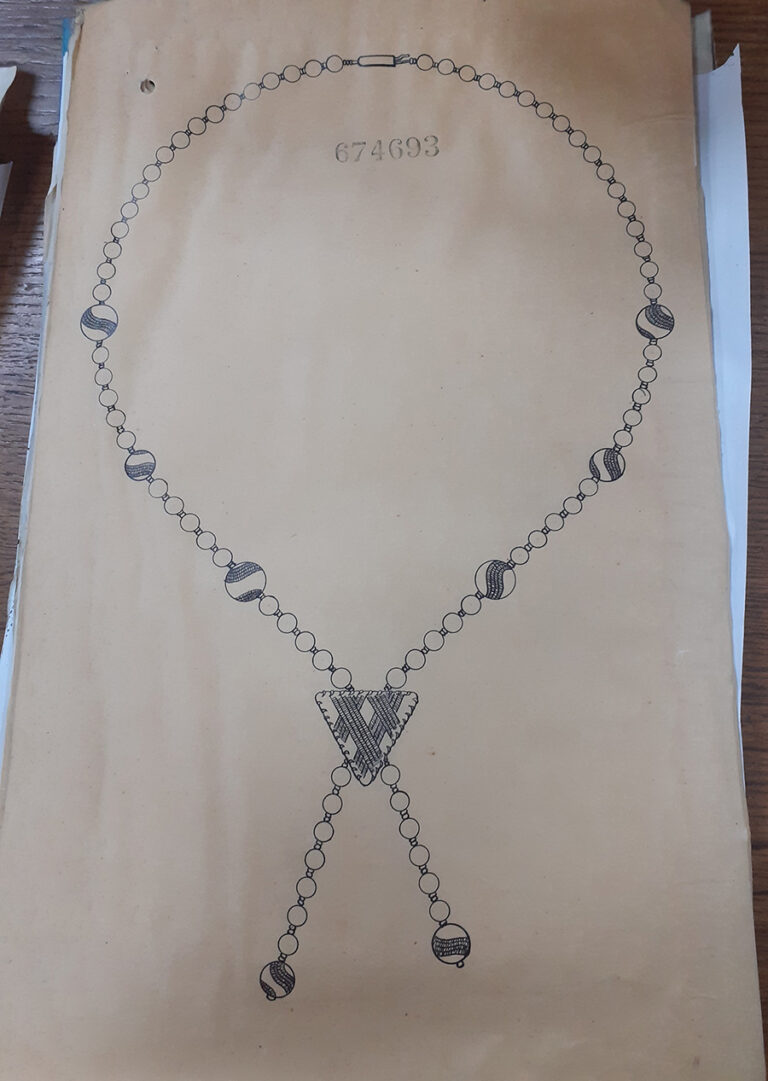
The iconic cloche hat, which had been worn as early as the 1910s (footnote 6), exploded in popularity in the 1920s, complementing the shorter bobbed hairstyles which many women were adopting. This example was registered on 6 November 1922 by Alexander Burnet, Barbican, London.
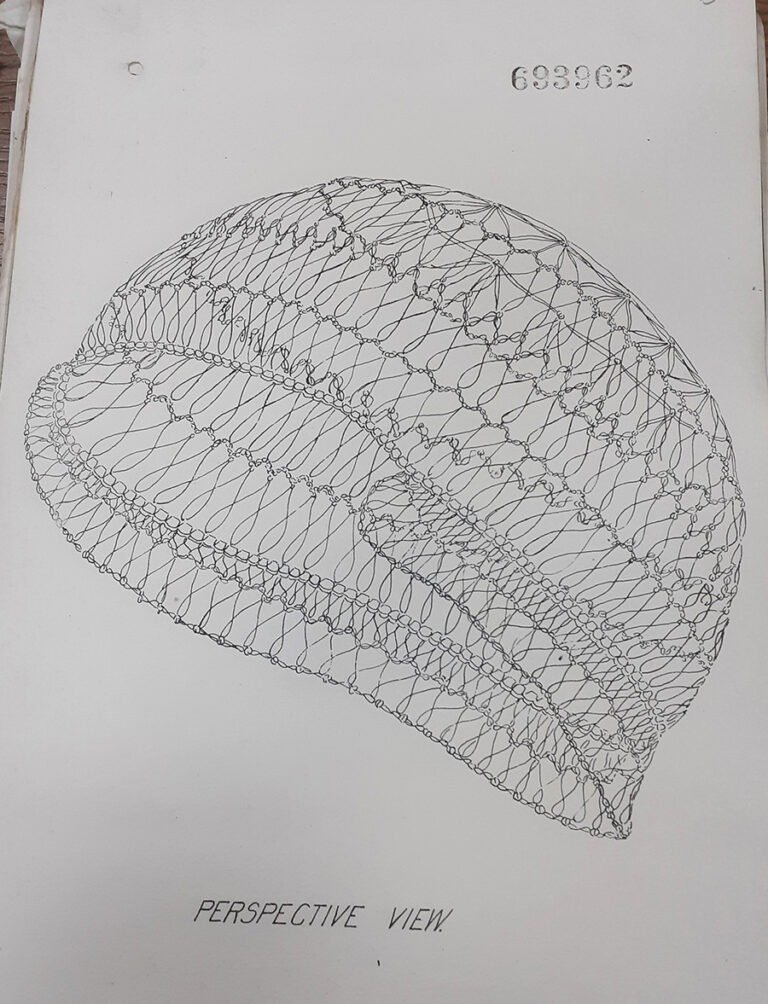
Colour and pattern
Designers in the 1920s experimented with vivid colours and bold patterns, taking inspiration from modern art and design movements such as Art Deco to bring in clean lines and geometric shapes. Global influences also made it into new designs, as designers catered for public enthusiasm for travel and exoticism (footnote 7).
Designers registered textiles intended for dressmaking as well as for home furnishing. In addition, many wallpapers were registered in the non-textiles category. The representations of these designs tend to be in the form of physical samples and they give a valuable insight into the development of pattern in the 1920s. A selection of original fabric designs from the 1920s is on display at The National Archives’ exhibition, The 1920s: Beyond the Roar.
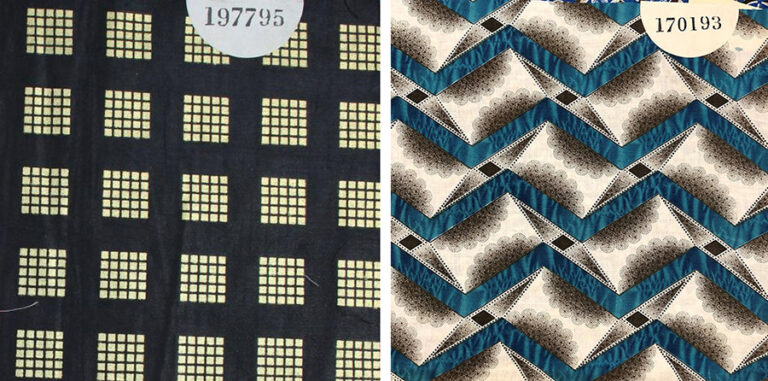
A vast number of textiles were registered in the period by the Calico Printers’ Association Ltd., a British company which had been founded in 1899, from the amalgamation of 46 printworks and 13 merchants. The Association dominated the printed cloth industry in the early 20th century (footnote 8).
Designers such as Gabrielle ‘Coco’ Chanel and Liberty & Co. are found within the collection. The pink and blue fabric design on the left was registered by Gabrielle Chanel in 1929 and is made of lightweight wool and silk. Another sample of this fabric is currently on display at the Victoria and Albert Museum (footnote 9). Liberty & Co. was a prolific producer of textile designs in the 1920s and the company worked with freelance designers and other manufacturers to sell textiles under the Liberty Art Fabrics name (footnote 10).
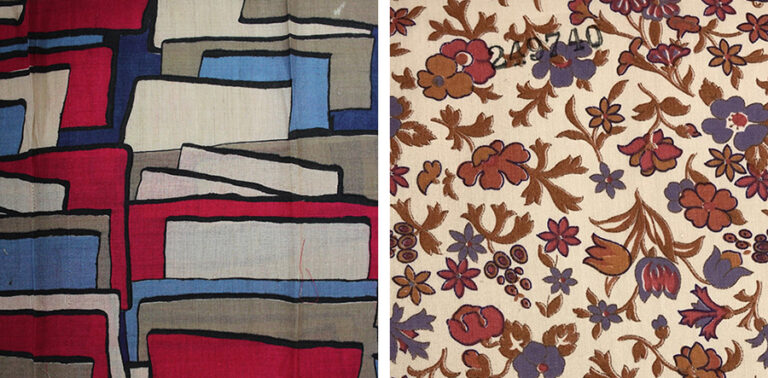
In the home
Creativity in the use of colour and pattern extended to wallpaper in the 1920s and there are many striking examples of designs for ‘paper hangings’ in the registered design collection. The wallpaper on the left, exhibiting bold foliage in bright colours, was registered by the Wall Paper Manufacturers Ltd. (WPM) in 1927. Based in Manchester, this was a powerful company which, like the Calico Printers Association, had been formed from the amalgamation of multiple other companies (footnote 11). The wallpaper on the right, which exhibits elements of the Chinoiserie style, was registered by the Lees Paper Staining Company Ltd on 30 July 1925. This company was eventually acquired by WPM in 1934 (footnote 12).

The influence of the Art Deco movement is most evidently seen in furniture and interior design of the 1920s. Designers incorporated elegant angular shapes with clean bold lines into all kinds of furniture and ornaments. This lamp was registered on 30 July 1925 by Baronne D’Eppinghoven, (née Anne Lydie Harris), who was living in Brussels, Belgium.

Designers also embraced practicality in their designs and responded to the requirements of new technologies in the home. The table below was described as ‘a table for a gramophone and gramophone records’ and boasted a sound chamber and a record chamber at the back. It was registered on 9 November 1922 by Jesse Nathaniel Lewin of Stamford Hill.
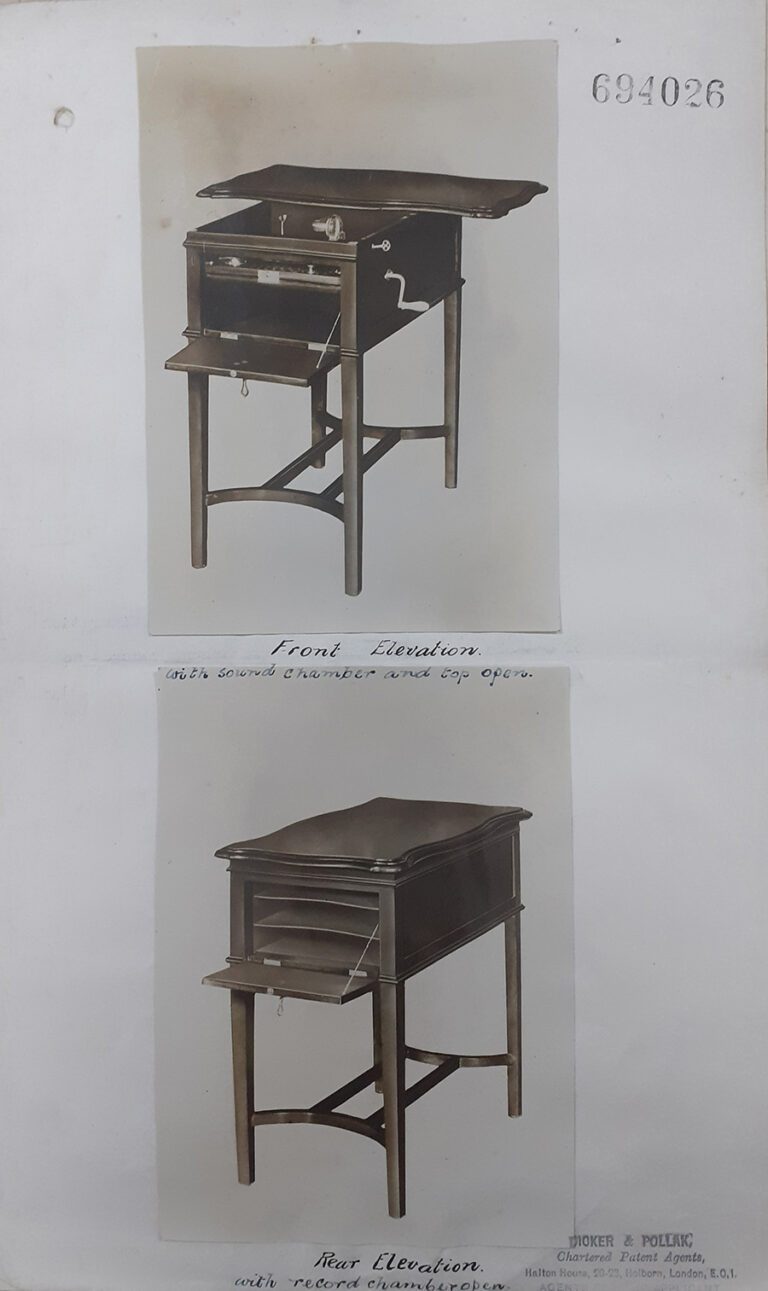
In 1924 a series of perfume atomiser bottles was registered by The DeVilbiss Co. Ltd., with the address listed as Colneside Works, West Drayton, Middlesex. Founded in the 1880s, DeVilbiss started as a manufacturer of atomisers for medical purposes, but subsequently became a significant producer of decorative perfume bottles in the era (footnote 13). These beautiful bottles certainly exhibit the bold elegance which was typical of 1920s design.

Exploring the 1920s through the registered design collection
The registered designs held at The National Archives offer us a fascinating insight into the design landscape of the 1920s, giving us examples of innovative decorative design ideas which could be found in every area of society. The records are also unique in that they tell us about designs which may never have actually been manufactured, let alone been commercially successful. They therefore show us more about the design ideas that were circulating in the decade than we could learn from surviving objects.
As well as designs from well-known companies and individuals, these records shed light on the little projects and lesser-known ideas which might otherwise be forgotten. We can find many oddities in the collection. The design below is for a tobacco pipe in the shape of a tennis racquet and ball, no doubt attempting to cater to the public enthusiasm for tennis in the 1920s. It was registered in 1927 by J. L. L. Vincent-Genod of French pipe manufacturing company J. Vincent Fils.

For more information about our registered design collection and for advice on how to conduct your own research, please see our research guide to Registered Designs.
Footnotes
- Charlotte Fiell, ‘1920s Fashion’, Welbeck (2021), p. 15
- Charlotte Fiell, ‘1920s Fashion’, Welbeck (2021), p. 14
- The National Archives, Illustrated London News, January-June 1929. Catalogue ref: ZPER 34/174
- Charlotte Fiell, ‘1920s Fashion’, Welbeck (2021), p. 23
- Marie-Josèphe Bossan, ‘The Art of the Shoe’, Parkstone International (2019), p. 211
- Charlotte Fiell, ‘1920s Fashion’, Welbeck (2021), p. 33
- Charlotte Samuels, ‘Art Deco Textiles’, V&A Publications (2003), pp. 7-8
- Lesley Jackson, ’20th Century Pattern Design’, Mitchell Beazley (2002), p. 27
- Victoria and Albert Museum, ‘Dress fabric’, (accessed 6 April 2022)
- Lesley Jackson, ’20th Century Pattern Design’, Mitchell Beazley (2002), p. 23
- Lesley Jackson, ’20th Century Pattern Design’, Mitchell Beazley (2002), p. 19
- Historic Houses Trust, ‘Lees Paper Staining Co. Ltd’, (accessed 5 April 2022)
- Wood Library-Museum of Anaesthesiologists, ‘DeVilbiss Atomizers’, (accessed 6 April 2022)
20sPeople at The National Archives
20sPeople at The National Archives explores and shares stories that connect the people of the 2020s with the people of the 1920s. Accompanying the release of the 1921 Census of England and Wales, 20sPeople shows what we can learn by connecting with those who have gone before us. Find out more at nationalarchives.gov.uk/20speople.
What a fantastic read, thank you. It flowed from aspect to aspect of design and some beautiful photos to enhance the description of how different areas of fashion were influenced. Thoroughly immersed it it all I was! Cheers.